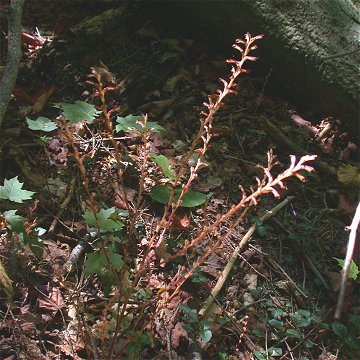

Epifagus virginiana - (image 1 of 4)
Taxonomy
Family: Orobanchaceae
Habitat
Woodlands. Prefers large beech trees and little disturbance of the ground layer.
Associates
Parasitic on the roots of Fagus grandifolia (American Beech).
Distribution
Quebec and Nova Scotia west to WI, south to FL and LA.
Morphology
Perennial to 0.5 m. Stems pale brown, freely branching. Leaves alternate, scale-like. Flowers dimorphic, axillary; upper flowers zygomorphic to 1 cm long; corolla 4-lobed, white or pinkish, with two brown-purple stripes; lower flowers pistillate, less than 5 mm long, strongly 5-ribbed; calyx 5-lobed; corolla closed, cap-like, forced off by developing ovary.
Notes
Flowers August to September
Wetland indicator: Upland
Often easy to find beneath beech trees in the fall. The flowering stems often persist over the winter and can sometimes still be found with newly emerging flowers a year later. The genus Epifagus is monospecific.
References
Gleason, Henry A.
and A. Cronquist. 1991. Manual of Vascular Plants of Northeastern United States
and Adjacent Canada. Second Ed.
The New York Botanical Garden. Bronx, NY
Swink, F. and G. Wilhelm. 1994. Plants of the Chicago Region.
Indiana Academy of Science. The Morton Arboretum. Lisle, Illinois.
|
Michael Hough © 2004 |